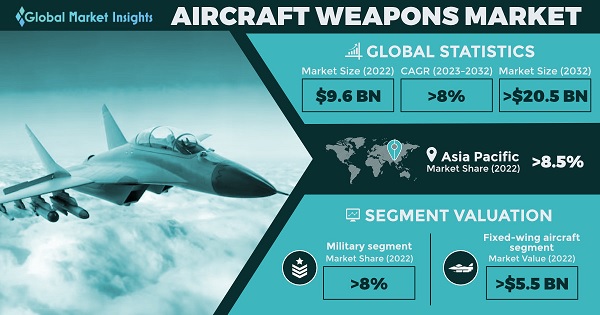Home > Aerospace & Defense > Defense and Safety > Weapons and Ammunition > Aircraft Weapons Market
Aircraft Weapons Market Size
- Report ID: GMI6992
- Published Date: Oct 2023
- Report Format: PDF
Aircraft weapons Market Size
Aircraft Weapons Market was valued at USD 9.6 Billion in 2022 and is estimated to register a CAGR of over 8% between 2023 and 2032. The Advances in stealth technology and long-range precision strike capabilities have indeed played a pivotal role in shaping the development of next-generation weapons systems, driving the aircraft weapon market growth. Stealth technology involves designing aircraft, missiles, and other military platforms to minimize their radar, infrared, and acoustic signatures. This makes them less detectable and trackable by enemy air defense systems. Key developments in stealth technology include the design of aircraft with reduced radar cross-sections, advanced materials that absorb or deflect radar waves, and exhaust systems that minimize heat signatures. Stealth technology allows for the element of surprise and increased survivability in hostile environments.
Aircraft weapons, also known as ordnance, are a crucial component of military aviation. These specialized tools are designed and built to serve various functions, enhancing the combat capabilities of aircraft. Aircraft weapons encompass a wide range of munitions, including missiles, bombs, torpedoes, gun systems, and other payloads that can be carried and deployed by fixed-wing aircraft, rotorcraft, drones, and other aerial platforms. The primary purpose of aircraft weapons is to achieve air superiority and project power by engaging and neutralizing targets on land, at sea, or in the air. These weapons are meticulously engineered for precision and lethality, while also considering factors like aerodynamics, weight, and compatibility with the aircraft's systems.
| Report Attribute | Details |
|---|---|
| Base Year: | 2022 |
| Aircraft Weapons Market Size in 2022: | USD 9.6 Billion |
| Forecast Period: | 2023 to 2032 |
| Forecast Period 2023 to 2032 CAGR: | 8% |
| 2032 Value Projection: | USD 20.5 Billion |
| Historical Data for: | 2018 to 2022 |
| No. of Pages: | 200 |
| Tables, Charts & Figures: | 405 |
| Segments covered: | Aircraft Type, Weapon Type, Range, Guidance system, end use, and region |
| Growth Drivers: |
|
| Pitfalls & Challenges: |
|
The Limited defense budgets can significantly constrain the aircraft weapons market. Developing, procuring, and maintaining advanced weapon systems is costly, and in many cases, governments face financial limitations. This can lead to delays in procurement, scaled-down programs, and reduced investments in innovative weaponry. Budgetary constraints are a prominent restraint in the aircraft weapons industry. Defense budgets are often limited, and developing, procuring, and maintaining advanced weapon systems is a costly endeavor. As a result, many governments face financial limitations that affect the growth and innovation in this market. These budgetary constraints can lead to delays in procurement, scaled-down programs, and reduced investments in innovative weaponry, potentially hindering military modernization efforts and limiting the deployment of cutting-edge technologies in the aerospace and defense sectors.

